Double belt buckle that undid a double murder
An ‘unholy’ crime in a ‘holy’ city!
A chillingly gripping double murder reeking with illicit booze, vehicle hijackings and bodies burnt to ashes with only a tell-tale double belt buckle which finally leads to the gallows. Not within the pages of a thriller set in Anuradhapura but very real, leaving the lives of many shattered just a little more than 50 years ago.
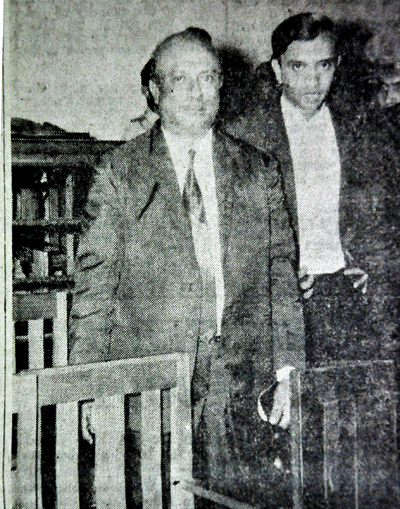
The first accused in the Kalattawa double murder case, Alfred de Zoysa (on left) walking out of court after the verdict of guilty on May 12, 1970. (From the Archives – The ‘SUN’. Pic by Berty Mendis)
His demeanour was gentle and for people who knew him he was a soft-spoken man, always with a smile wreathing his lips.
Well-known and influential was big businessman Alfred de Zoysa seen around Anuradhapura New Town. He had a finger in everything – whether running the thriving arrack business in the two taverns in Anuradhapura or undertaking irrigation contracts to repair the bunds of the numerous wewas (tanks) dotting the North Central Province.
He owned large swathes of land in many areas including Kalattawa, about eight km from Anuradhapura, but lived close to the Kada Panaha in the heart of the Anuradhapura New Town, a stone’s throw from politicians such as Maithripala Senanayake and K.B. Ratnayake, famous in times of yore.
Everyone knew everyone else in small towns such as Anuradhapura in the 1950s and ’60s. The middle-class consisting of professionals including doctors, lawyers and senior government officials worked during the day and partied during the night at the Rowing Club by the Nuwara Wewa, dancing into the wee hours of the morning, with arrack bought from Zoysa’s taverns flowing generously.
The tiny trigger for the sequence of events which left the people of Anuradhapura aghast was a routine calling of tenders to run the taverns there. Whereas Zoysa had been ruling the roost here, on that day in 1966, came tavern renter S.R. Kandiah with his men from Jaffna to make a bid.
“It started off as a highway robbery,” says then Officer-in-Charge (OIC) of the Padaviya Police Station, Inspector S.S. Navaratnaraja, now 80, when we meet him in his home in Wellawatte on Wednesday evening.
The story unfolds how Kandiah arrived in a car bringing with him Rs. 66,500 for the tender and how Zoysa entertained him at the Nuwara Wewa Resthouse but urged him to keep away from Anuradhapura as it was his territory, bringing to mind tales of Mafia families carving out their strongholds in America.
Zoysa had also given Kandiah a gift of Rs. 65,000, a princely sum, as a token of goodwill, says Mr. Navaratnaraja.
Back they journeyed to Jaffna, along lonely stretches with scrub jungle closing in all around, oblivious to what awaited them at the Boo Oya bridge along the Medawachchiya-Vavuniya Road.
It was a heist – armed men obstructed the road, flung chillie powder at the Jaffna men and brazenly made off with their vehicle and all the cash. The hijacked vehicle was later found abandoned at Galkulama on the Anuradhapura-Matale Road.
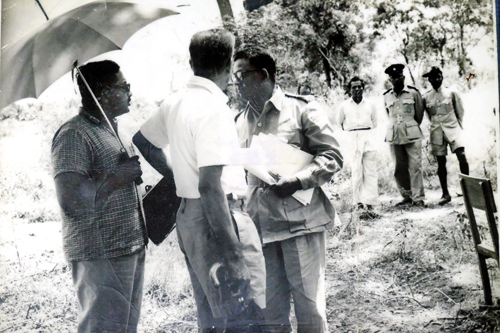
When the Kalattawa excavations unearthed the charred bones and buckle of P.K.D. Perera, among those at the crime scene in March 1967 were Inspector General of Police Aleric Abeygunawardena (in shorts); CID’s Superintendent of Police Tyrrell Goonatilleke; and Anuradhapura ASP A. Mahendran in uniform
The waylaid men fled in terror to the Vavuniya Police Station to complain about the robbery only to be told that the crime came under the jurisdiction of the Medawachchiya Police Station at that time being headed by Sub-Inspector (SI) Nalin Delgoda.
Back in the 1960s, remote was the Medawachchiya Police Station, 14 miles from Anuradhapura and for young and dashing Mr. Delgoda it was a quiet posting. He knew Zoysa as an apothecary as well as a contractor handling huge irrigation infrastructure, with a large contingent of workers and also heavy machinery under him.
That evening came the complaint of the robbery of hard cash and a vehicle at Kalukunnammaduwa and for Mr. Delgoda, now 81, who launched the investigation “it was like looking for a pin in a haystack”.
While Mr. Delgoda was doing his part of the investigation, Mr. Navaratnaraja had been promoted and sent to the Anuradhapura Police Station as OIC Crimes in January 1967.
Up to now, January 14, 1967 is unforgettable for him – it was Thai Pongal day and he had promised his wife that he would accompany her to the kovil in the evening. However, it was not meant to be.
“Around 5.30 p.m. a distraught young man by the name of Karaliyedda rushed in, mumbling and complaining of a person about to be murdered, to be burnt to death,” recalls Mr. Navaratnaraja.
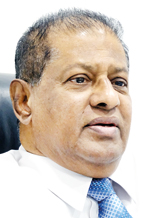
Then Medawachchiya OIC: Nalin Delgoda
Off went the OIC Crimes with a police party to Kalattawa to find in the wadiya in Zoysa’s fiefdom, a shivering and speechless youth tied to a camp cot with a can of diesel near him. A golaya of Zoysa, W. Piyadasa alias Kalu Albert, later identified as an Island Reconvicted Criminal (IRC) had vanished from the scene.
Rescuing him in the nick of time, the police then brought him to the Anuradhapura Hospital to be treated, placing a 24-hour guard for his protection while recording his bombshell statement.
He was a “cycle boy” working for Zoysa. He had asked for his wages as he wanted to go home but had not been paid his dues and as such had pawned the cycle. This had brought Zoysa’s wrath on him with orders that he be eliminated – “marala dapang”. He had been caught, tied up and assaulted mercilessly, says Mr. Navaratnaraja.
In search of Zoysa then went Mr. Navaratnaraja, directly to his home close to the Kada Panaha but he was not there, only two vans transporting illicitly brewed hooch (kasippu) which Zoysa was mixing with legal arrack to make a fast buck. Bottling equipment had also been found, where the legally-produced arrack bottles were adulterated, filled with a mix and re-stoppered.
The police team then went to the tavern but as he was not there too, they returned to his home, parking their vehicle a little distance away. Mr. Navaratnaraja knew for a certainty that Zoysa was there as his jeep was a giveaway and even though Zoysa’s driver attempted to warn his boss by tooting the horn, Mr. Navaratnaraja had stopped him.
Taken by surprise, Zoysa resisted arrest by trying to pull out something from his hip pocket which later turned out to be a revolver. It had jammed, smiles Mr. Navaratnaraja. “We arrested Zoysa that day and began the investigation but the police did not know the magnitude of the crimes.”
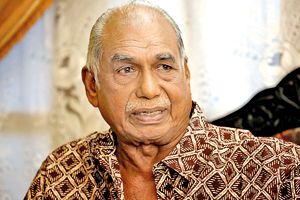
Then OIC Crimes: S.S. Navaratnaraja. Pix by M.A. Pushpa Kumara, Ranjith Perera and Amila Gamage
With the arrest of Zoysa, information about his notorious activities began trickling in to the police as those who had been afraid of him as he was supposed to be very powerful became bolder with him being in custody.
Simultaneously, the CID too was on Zoysa’s trail for there had been tip-offs that an Austin Cambridge car of All Ceylon cricketer C.I. Gunasekara had been robbed and was in his possession and Julius Sandrasagara who worked for Zoysa was missing, with his family desperate for news of the young man. By now Mr. Delgoda had also been transferred to the CID.
Zoysa, meanwhile, had been produced in court and granted bail.
When the police got a tip-off that Vincent, an employee who knew about the Austin Cambridge, was to be “bumped off” by Zoysa after sending him to Oddusuddan in the first week of March 1967, Mr. Navaratnaraja had followed hot on his heels and warned him about Zoysa’s plot.
Soon after Vincent had admitted that he had buried the Austin Cambridge, the police led by Mr. Navaratnaraja had once again arrested Zoysa — who had run into a neighbour’s home and hidden under a bed — and taken him to Kalattawa.
Do you know that Zoysa’s gang was using the stolen Austin Cambridge with the last digit removed from the original number plate says this veteran police officer, pointing out that after the gang used this car to rob the Jaffna tavern renter, Zoysa had ordered that the car be hidden in the Warawewa jungles in Puttalam.
Later, on getting wind that the CID was on his trail, Zoysa had devised a plan to get rid of the car forever. The owner of more than 150 acres of land at Kalattawa, he had got three sets of labourers to do the job, without knowing what they were doing. The first set had cleared the land of all trees, the second set had ploughed the land and the third set had dug a large pit, says Mr. Navaratnaraja, creating an image of frenetic activity. With the labourers being sent away after that, Vincent had been ordered by Kalu Albert to drive the vehicle into the pit, after which it was earthed over by a bulldozer. The others who were in the know were mechanic P.K.D. Perera and another employee Sandrasagara.
As things were hotting up, Vincent was becoming a liability for Zoysa and hence the decision to bump him off. However, for the police and the CID, Vincent turned out to be an asset, as firstly dumbfounded by the changes to the Kalattawa land, he suggested that they dig close to the sole huge tree standing sentinel there.
“Fifteen feet down, the shovels hit the windscreen,” says Mr. Navaratnaraja, adding that much later Vincent also confessed to seeing fires, which at that time he thought were due to chena clearing, but with Zoysa looking intently towards them.
When he pointed out the place of the fires, excavations had been conducted in the presence of Anuradhapura Magistrate Parinda Ranasinghe and the then Government Analyst…….bringing to light some charred bones, the double buckle of the belt of Perera and the frame of his tool-box.
All that was left of the bones we collected in a small cigarette tin, says Mr. Delgoda, with Mr. Navaratnaraja demonstrating how Perera was “a hefty fellow” who carried his tool box around and was known as ‘Kulu Gedi Baas’. Perera had to wear two belts around his waist to keep his sarong in place and it was this double-buckle that was unearthed from Kalattawa.
Commending the CID for the meticulous investigations, Mr. Navaratnaraja talks with pride on how they even traced the shop from which the belt had been bought by Perera.
| “Extraordinary and unparalleled in the history of murder cases” | |
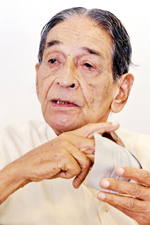 Then Superintendent of Welikada Prisons: Cutty Jansz The astute businessman that Alfred de Zoysa was, he bargained heavily and sold part of his property and wrote the balance to his family before his day of reckoning, said the then Superintendent of Prisons, Cutty Jansz who was part of the team in attendance when Zoysa was hanged at the Welikada Prison. As Zoysa was a Roman Catholic, he performed his religious obligations under Chaplain Rev. Claude Lawrence and did the final walk from Death Row to the hangman without flinching or hesitancy, says Mr. Jansz, now 87, adding that the Chaplain’s last words were: “Alfred, remember the angels will be there to collect you when you drop. Have no fear.” One of the final acts of Zoysa had been to donate ata pirikara on behalf of his co-accused. While the non-summary inquiry was conducted by the Anuradhapura Magistrate Parinda Ranasinghe, the trial by an English speaking jury of seven members which began in the Colombo Assizes on October 26, 1969 was heard under Justice V.T. Panditha Gunawardene, we gather from yellowed newspapers of those times. The trial had lasted 126 days, beginning on October 26, 1969 with Zoysa being found guilty of the murder of P.K.D. Perera (54) in a unanimous decision by the jury and then sentenced to the gallows on May 12, 1970. The jury had deliberated for about six hours, giving their verdict just before 7 p.m. Thereafter, Justice Gunawardene had passed the death sentence on Alfred de Zoysa, W. Piyadasa (Kalu Albert) and W. Fernando alias Willie Mama. Zoysa had been found guilty of conspiracy to murder Perera and aiding and abetting Kalu Albert, Willie Mama and another to commit the murder of Perera. He had been found not guilty of conspiracy to murder Julius Sandrasagara (34) and committing his murder. The other two accused had been found guilty of the conspiracy to murder Perera but not guilty of the murder of Perera and conspiracy to murder Sandrasagara. The case had been described as “extraordinary and unparalleled” in the history of murder cases as there was no body and only 150 bone fragments, a belt buckle and some clothing had been recovered. “I have sent Sandrasagara and Perera to the moon and I’ll send you also to the moon.” These words of Alfred de Zoysa quoted by the ‘cycle boy’ (assaulted, tied up and then saved by the police) in his unshakeable statement were the final push that made the verdict swing towards guilty, says Police Officer S.S. Navaratnaraja who recorded it. Reporting the cold-blooded murder of Sandrasagara, it is journalist Geoff Wijesinghe who states how an eye-witness who helped bury him, emotionally told court how the victim, on his knees, begged for his life from the killers: “Please, I beg of you, do not shoot me. Please do not kill me.” But two chambers of high-powered revolver were fired at him and another killer fired a third shot into the already dying man. Justice Gunawardene, meanwhile, in his address to the jury had stated that “in the recorded history of murder trials in this country, this case that you have been called upon to decide on is singularly unusual……the accused were charged with murder without the production of the body. The fact that there was no body did not mean there was no murder. Called the longest running murder trial in Ceylon in those times, the prosecution had summoned 63 and the defence five witnesses. The lawyers appearing for the state were Deputy Solicitor-General T.A. de S Wijesundera; Senior Crown Counsel Percy Colin-Thome; and Crown Counsel Daya Perera and K. Ratnesar. Queen’s Counsel A.H.C. de Silva, Sunil Rodrigo, K. Sivananthan, Nihal K.M. Perera instructed by Lucien V. Perera and G.G. Ponnambalam QC had appeared for the first accused Alfred de Zoysa. The other high-level police officers who had been part of the probe were CID’s Chief Inspectors M.K.J. Perera and Upali Seneviratne and Inspector Bennet Perera and Anuradhapura Headquarters Inspector S.B.W. de Silva.
|


